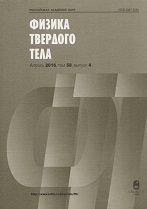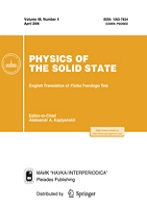|
This article is cited in 2 scientific papers (total in 2 papers)
Semiconductors
Frequency dependence of the dielectric loss angle in disordered semiconductors in the terahertz frequency range
M. A. Ormont, I. P. Zvyagin
Lomonosov Moscow State University
Abstract:
Frequency dependence of the real part of the conductivity $\sigma_1(\omega)$ in the region of the transition from almost linear $(s<1)$ to quadratic $(s\approx2)$ can indicate a change in the conduction mechanism (the transition from the variable-range to the fixed-range hopping with increasing frequency); in this case, the sharpness of the change in the slope of the frequency characteristic is related to the dependence of the preexponential factor of the resonance integral on the intercenter distance in the pair. The frequency dependence of the imaginary part of the conductivity $\sigma_2(\omega)$ has no kink in the vicinity of the transition frequency $\omega_{\operatorname{cr}}$, remaining almost linear. A large dielectric loss angle $|\operatorname{ctg}\gamma| = |\sigma_2|/\sigma_1$ can indicate that the imaginary part of the conductivity at $\omega<\omega_{\operatorname{cr}}$ is defined by the larger zero-phonon contribution in $\sigma_2^{\operatorname{res}}$ the region of weak variation in the loss angle $\gamma(\omega)$, which significantly exceeds the relaxation contribution $\sigma_2^{\operatorname{res}}$.
Citation:
M. A. Ormont, I. P. Zvyagin, “Frequency dependence of the dielectric loss angle in disordered semiconductors in the terahertz frequency range”, Fizika Tverdogo Tela, 60:5 (2018), 880–887; Phys. Solid State, 60:5 (2018), 882–889
Linking options:
https://www.mathnet.ru/eng/ftt9192 https://www.mathnet.ru/eng/ftt/v60/i5/p880
|


| Statistics & downloads: |
| Abstract page: | 78 | | Full-text PDF : | 35 |
|





 Contact us:
Contact us: Terms of Use
Terms of Use
 Registration to the website
Registration to the website Logotypes
Logotypes









 Citation in format
Citation in format 
